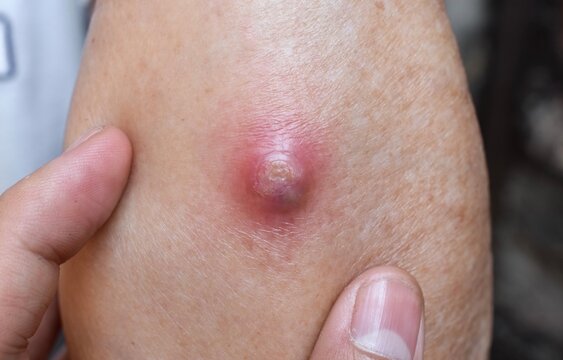
What is folliculitis?
Folliculitis is inflammation of hair follicles. S. aureus is the commonest cause of a
bacterial folliculitis. P. aeruginosa may cause folliculitis after hot tubs or whirlpools.
Superficial bacterial folliculitis is usually self-limiting but may be recurrent. Deeper
folliculitis involving the entire follicle and surrounding tissues (furunculosis) heals
with scarring or can progress to cellulitis.
Community-acquired strains of S. aureus
carrying genes that encode the neutrophil cytotoxin panton – Valentine leukocidin
(PVL) cause numerous deep furuncles, abscesses, cellulitis, and necrotizing
pneumonia in healthy young adults and children. Severe and recurrent staphylococcal
skin disease, which is difficult to treat, is leading to more hospital admissions.

What may predispose to bacterial folliculitis or furunculosis?
(The evidence is inconclusive.)
• Occlusion or maceration; tropical climates.
• Hot tubs or whirlpools (P. aeruginosa folliculitis).
• Crowded living conditions, poor hygiene, malnutrition.
• Diabetes, alcoholism, immunodeficiency, or oral corticosteroids.
• Blood dyscrasias and disorders of neutrophil function.
What should I look for?
• Superficial folliculitis may be itchy; deep folliculitis is tender.
• Perifollicular erythematous papules or small pustules—the pustule may be pierced
by a hair.
• Crusting of follicular openings when pustules rupture.
• Tender, inflamed furuncles (‘boils’) with abscesses in deep infection.
• Furuncles may discharge and heal with scarring.
• A group of deeply infected follicles leading to a tender erythematous nodule—a
carbuncle. Pus discharges from several points.
• Follicular pustules or papules 8–48h after exposure to hot tub or whirlpool at sites
covered by bathing suit (P. aeruginosa folliculitis).

What should I do in bacterial folliculitis?
• Remove or minimize precipitating factors.
• Antiseptic washes are all that is needed in most superficial cases.
• If folliculitis does not settle, take swabs for culture from pustules.
• Alcohol-based washes or triclosan are effective against MRSA and strains of
Staphylococcus producing PVL.
• Topical antibiotics, e.g. 2% mupirocin ointment, clindamycin lotion, or
erythromycin lotion may be indicated.
• Deep infection requires oral anti-staphylococcal antibiotics.
• Carbuncles should be incised and drained surgically.
How should I manage recurrent cutaneous bacterial infections?
• Culture pus and swabs from potential carrier sites, e.g. nose, axilla, groin, and
perineum, in the patient and the family.
• Exclude diabetes, and minimize other predisposing factors.
• Decolonize the skin with daily antimicrobial skin washes with triclosan,
chlorhexidine, or benzalkonium chloride (Dermol 600®, oilatum plus®, or
Aquasept®).
• Treat chronic S. aureus nasal carriage with short bursts of 2% mupirocin ointment.
• Benzoyl peroxide 5% gel applied bd may help to prevent recurrent staphylococcal
folliculitis.
• Consider oral antibiotics, but check sensitivities, and choose wisely.
• Reinforce hygiene measures—recommend liquid antiseptic soap, instead of bars of
soap, and separate towels for family members to reduce the risk of recolonization by
household fomites.